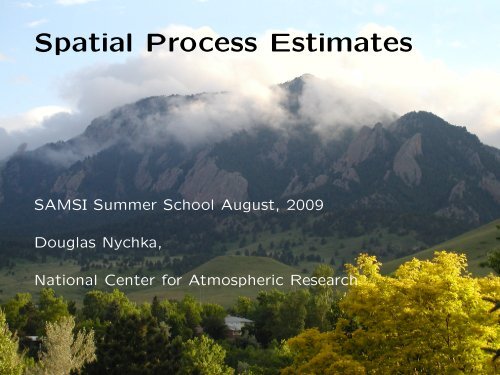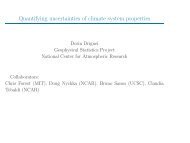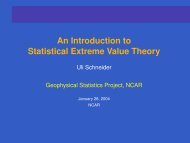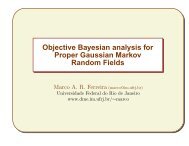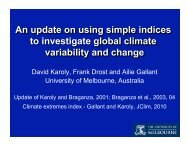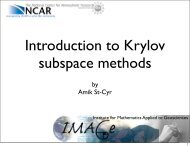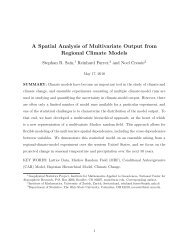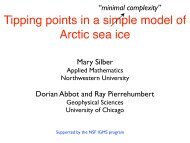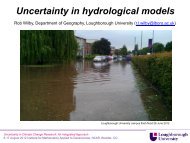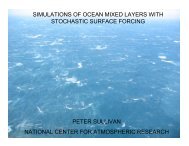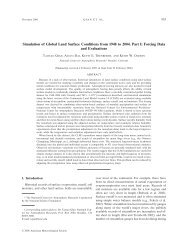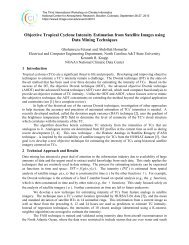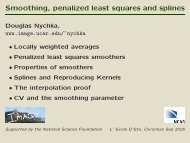Spatial Process Estimates - IMAGe
Spatial Process Estimates - IMAGe
Spatial Process Estimates - IMAGe
Create successful ePaper yourself
Turn your PDF publications into a flip-book with our unique Google optimized e-Paper software.
<strong>Spatial</strong> <strong>Process</strong> <strong>Estimates</strong><br />
SAMSI Summer School August, 2009<br />
Douglas Nychka,<br />
National Center for Atmospheric Research
Outline<br />
• A spatial model and Kriging<br />
• Kriging = Penalized least squares = splines<br />
• Robust Kriging.<br />
• Identifying a covariance function<br />
• Inference<br />
Supported by the National Science Foundation<br />
2
The additive model<br />
Given n pairs of observations (x i , y i ), i = 1, . . . , n<br />
ɛ i ’s are random errors.<br />
y i = g(x i ) + ɛ i<br />
Assume that g is a realization of a Gaussian process.<br />
MN(0, σ 2 I)<br />
and ɛ are<br />
Formulating a statistical model for g<br />
makes a very big difference in how we solve the problem.<br />
3
A Normal World<br />
We assume that g(x) is a Gaussian process,<br />
ρk(x, x ′ ) = COV (g(x), g(x ′ ))<br />
For the moment assume that E(g(x)) = 0.<br />
(A Gaussian process ≡ any subset of the field locations has a multivariate<br />
normal distribution. )<br />
We know what we need to do!<br />
If we know k we know how to make a prediction at x!<br />
ĝ(x) = E[g(x)|data]<br />
i.e. Just use the conditional multivariate normal distribution.<br />
4
A review of the conditional normal<br />
and<br />
u ∼ N(0, Σ)<br />
u =<br />
(<br />
u1<br />
u 2<br />
)<br />
( )<br />
Σ11 , Σ<br />
Σ = 12<br />
Σ 21 , Σ 22<br />
[u 2 |u 1 ] = N(Σ 2,1 Σ −1<br />
1,1 u 1, Σ 2,2 − Σ 2,1 Σ −1<br />
1,1 Σ 1,2)<br />
(distribution of u 2 given u 1 )<br />
5
Our application is<br />
u 1 = y<br />
and<br />
(the Data)<br />
u 2 = {g(x 1 ), ...g(x N )}<br />
a vector of function values where we would like to predict.<br />
6
The Kriging weights<br />
Conditional distribution of g given the data y is Gaussian.<br />
Conditional mean<br />
ĝ = COV (g, y) [COV (y)] −1 y = Ay<br />
rows of A are the Kriging weights.<br />
Conditional variance<br />
COV (g, g) − COV (g, y) [COV (y)] −1 COV (y, g)<br />
These two pieces characterize the entire conditional distribution<br />
7
Kriging as a smoother<br />
Suppose the errors are uncorrelated Normals with variance<br />
σ 2 .<br />
ρK = COV (g, y) = COV (g, g)<br />
and<br />
COV (y) = (ρK + σ 2 I)<br />
ĝ = ρK(ρK + σ 2 I) −1 y<br />
= K(K + λI) −1 y = A(λ)y<br />
8
My geostatistics/BLUE overhead<br />
For any covariance and any smoothing matrix (not just A above) we<br />
can easily derive the prediction variance.<br />
Question: Find the minimum of<br />
over all choices of A.<br />
E [ (g(x) − ĝ(x)) 2]<br />
The answer: The Kriging weights ... or what we would do if<br />
we used the Gaussian process and the conditional distribution.<br />
Folklore and intuition: The spatial estimates are not very sensitive<br />
if one uses suboptimal weights, especially if the observations<br />
contain some measurement error.<br />
It does matter for measures of uncertainty.<br />
9
Kriging with a fixed part<br />
Adding a fixed component<br />
g(x) = ∑ i<br />
φ i (x)d i + h(x)<br />
d is fixed<br />
h is a mean zero process with covariance, k.<br />
10
BLUE/Universal Kriging<br />
Find d by Generalized least squares<br />
ˆd =<br />
(<br />
T T M −1 T ) −1<br />
T T M −1 y<br />
M = K + λI<br />
”Krig” the residuals<br />
ĥ = K(K + λI) −1 (y − T ˆd)<br />
11
In general:<br />
ĝ(x) = ∑ i<br />
φ i (x) ˆd i + ∑ j<br />
k(x, x j )ĉ j<br />
with<br />
ĉ = (K + λI) −1 (y − T ˆd)<br />
12
The spline connection<br />
Basis functions: determined by the covariance function<br />
Penalty function: Ω = K is based on the covariance.<br />
The minimization criteria:<br />
min<br />
d,c<br />
n∑<br />
i=1<br />
(y − (T d + Kc) i ) 2 + λc T Kc<br />
Kriging estimator is a spline with reproducing kernel k.<br />
λ is proportional to the measurement (nugget) variance<br />
13
Robust Kriging<br />
ρ(u) a robust function that grows slower than u 2<br />
The robust minimization criteria:<br />
min<br />
d,c<br />
n∑<br />
i=1<br />
ρ(y − (T d + Kc) i ) + λc T Kc<br />
An example of ρ and its derviative<br />
0 5 10 15<br />
−5 0 5<br />
−4 −2 0 2 4<br />
−4 −2 0 2 4<br />
14
Identifying a covariance function<br />
The Matern class of covariances:<br />
φ(d) = ρψ ν (d/θ)) with ψ ν a Bessel function.<br />
correlation<br />
0.0 0.2 0.4 0.6 0.8 1.0<br />
6<br />
2<br />
1<br />
0.5<br />
0.0 0.5 1.0 1.5 2.0<br />
θ a range parameter, ν smoothness<br />
at 0.<br />
• ψ ν is an exponential for ν =<br />
1/2 as ν → ∞ Gaussian.<br />
• m t h order thin plate spline in<br />
R d ν = 2m − d.)<br />
distance<br />
Compactly support Wendland covariance<br />
15
What kind of processes are these?<br />
Matern (.5,1.0,2.0) and Wendland (2.0)<br />
16
Correlations among ozone<br />
In many cases spatial processes also have a temporal component.<br />
Here we take the 89 days over the ”ozone season” and just find<br />
sample correlations among stations.<br />
correlation<br />
−0.5 0.0 0.5 1.0<br />
●<br />
●<br />
●<br />
●<br />
●<br />
●<br />
●<br />
●<br />
●<br />
●<br />
●<br />
0 100 200 300 400 500 600<br />
miles<br />
●<br />
●<br />
●<br />
●<br />
17
Comparison to the variogram<br />
Sample variogram for 89 days during summer 1987 :<br />
Variance<br />
0 100 300 500<br />
●<br />
●<br />
●<br />
●<br />
●<br />
●<br />
●<br />
●<br />
●<br />
●<br />
●<br />
●<br />
●<br />
●<br />
●<br />
●<br />
●<br />
●<br />
●<br />
●<br />
●<br />
0 50 100 150 200 250 300<br />
●<br />
●<br />
●<br />
●<br />
Distance (miles)<br />
”.” Sample variogram values<br />
”–” fitted linear function Variogram ∼ distance/θ<br />
●<br />
●<br />
●<br />
18
50<br />
Sensitivity to the covariance<br />
Exp (200) Matern (2, 200)<br />
150<br />
100<br />
100<br />
50<br />
50<br />
50<br />
150<br />
150<br />
150<br />
50<br />
100<br />
50<br />
50<br />
Thin plate spline Wendland (2, 180)<br />
100<br />
50<br />
100<br />
50<br />
0<br />
correlation<br />
0.0 0.4 0.8<br />
0 50 100 150 200 250 300<br />
distance<br />
19
10<br />
5<br />
5<br />
Sensitivity to the covariance (SE)<br />
Exp (200) Matern (2, 200)<br />
20<br />
20<br />
20<br />
10<br />
20<br />
20<br />
10<br />
5<br />
10<br />
10<br />
20<br />
20<br />
10<br />
20<br />
10<br />
10<br />
5<br />
10<br />
10<br />
20<br />
20<br />
10<br />
5<br />
10<br />
10<br />
10<br />
20<br />
10<br />
10<br />
20<br />
20<br />
20<br />
20<br />
10<br />
10<br />
5<br />
10<br />
10<br />
10<br />
10<br />
10<br />
10<br />
60<br />
50<br />
40<br />
30<br />
20<br />
5<br />
20<br />
10<br />
10<br />
5<br />
10<br />
10<br />
0<br />
Thin plate spline Wendland (2, 180)<br />
20
140<br />
140<br />
140<br />
140<br />
140<br />
140<br />
140<br />
140<br />
140<br />
140<br />
140<br />
140<br />
140<br />
140<br />
140<br />
Uncertainty in exceeding 140 PPB<br />
Mean field, four realizations of the conditional distribution<br />
Contours from 10 cases<br />
0 50 100 150 200<br />
21
Summary<br />
A spatial process model leads to a penalized<br />
least squares estimate<br />
A spline = Kriging estimate= Bayesian posterior<br />
mode<br />
For spatial estimators the basis functions are<br />
related to the covariance functions and can be<br />
identified from data<br />
22


